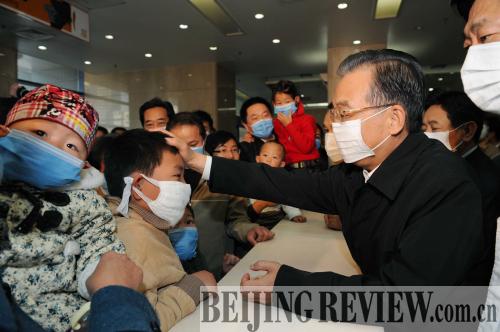|
 |
|
FIGHTING IT TOGETHER: Premier Wen Jiabao talks with a boy at Beijing Children's Hospital on October 31 during his visit with A/H1N1 flu patients and medical staff (RAO AIMIN) |
Laboratory-confirmed A/H1N1 influenza cases have been increasing by several hundred every day on the Chinese mainland since the second half of October and health authorities have alerted the public that new infections are nearing a pandemic peak in the country. Health authorities, meanwhile, are working earnestly to immunize high-risk groups to curb the spread of the virus.
The A/H1N1 influenza virus is responsible for nearly 80 percent of China's total current flu infections, said Liang Wannian, Deputy Director of the Ministry of Health's (MOH) Emergency Office.
"As the weather keeps getting colder, many regions are entering the traditional period of flu outbreak, and prevention and control work is becoming tougher," Liang said during an online interview posted on the Chinese Government's official website on October 29.
According to a November 2 MOH announcement on its website, the new virus is spreading in Chinese schools, from cities to the countryside and is accelerating in some regions. The ministry warned that the new round of outbreaks would last into next March.
As of November 4, more than 51,490 confirmed A/H1N1 flu cases had been reported on the Chinese mainland, with 75 percent recovering. There were 153 patients who were classified as being in critical condition. Of those, 43 have fully recovered, according to MOH statistics. There have been eight deaths from the flu so far.
The World Health Organization's (WHO) representative in China, Michael O'Leary, said on October 27 that the number of reported A/H1N1 fatalities may be the "tip of the iceberg," a day after the mainland reported its third official A/H1N1 death.
O'Leary said the fact that many deaths around the world are not being analyzed with lab tests means most A/H1N1 deaths likely go unrecorded.
More than 5,700 people had died from the swine flu virus worldwide as of November 3, according to WHO.
Zeng Guang, Chief Epidemiologist with the Chinese Center for Disease Control and Prevention, agreed, saying lab limitations mean some deaths possibly caused by the flu may not be confirmed.
"So far, no clear evidence can prove it, but the underestimation of A/H1N1 deaths, if it is happening, is definitely not intended," he said.
Massive immunization campaigns
China was the first country to issue a production license for A/H1N1 flu vaccine to pharmaceutical companies in September. Later that month, officials rolled out a nationwide vaccination program, one of the first countries in the world to do so.
In September, MOH released guidelines to regulate A/H1N1 flu vaccinations across the country through autumn and winter, which listed three high-risk groups of people: those offering services to the public, including service personnel of the People's Liberation Army and armed police forces, police, medical staff and teachers; primary and secondary school students; and patients with chronic or cardiovascular diseases. This brings the total population in urgent need of getting a flu shot on the Chinese mainland to about 390 million people, experts estimated.
All vaccinations are free to the public. MOH has also urged vaccine administrators to monitor and report any sickness from the immunization shots. Once such cases occur, inoculations must stop. Pregnant women and children less than 3 years old are banned from receiving the vaccine due to safety concerns.
More than 4 million people on the Chinese mainland had been inoculated with A/H1N1 vaccines as of November 3. About 33.4 million doses of the vaccine had been approved for use as of October 31, of which 26 million have been dispatched to local medical institutions.
A total of 100 million doses of A/H1N1 flu vaccines will be produced by the first quarter of next year based on estimates of the eight domestic vaccine manufacturers' current production capabilities, according to the ministry. Vaccines produced domestically have been stocked by the state and are so far unavailable on the market.
Concerns and myths
Many people who are eligible for vaccination against the new flu are not willing to get the shot. An October survey conducted by China Daily and major Web portal sohu.com found that more than 54 percent of the 2,000 respondents did not plan to be inoculated against A/H1N1 flu based on doubts over its safety and quality.
The survey results, published on China Daily on October 26, showed that nearly 70 percent of those who did not want the vaccine said they didn't trust its quality and safety; 23 percent of those who didn't want it said they feared potential adverse reactions. About 11 percent of the 2,000 respondents said they were young and healthy and did not need the vaccine.
On November 2, the MOH disproved an online rumor that Beijing's October A/H1N1 flu outbreak was caused by student vaccinations before the country's National Day celebration.
| 